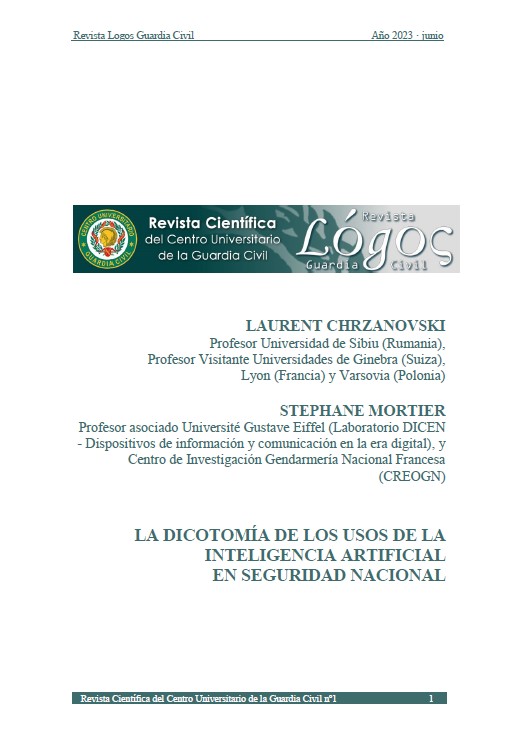THE DICHOTOMY OF USES OF ARTIFICIAL INTELLIGENCE IN NATIONAL SECURITY
Resumo
Artificial intelligence is probably the most important vector of security and law enforcement transformation. The need of security is a response to the defense of fundamental interests of states. How to protect these interest with artificial intelligence tools and technologies from foreign states? Más allá de las principales potencias estatales, es necesario abordar el entorno económico de la inteligencia artificial. The main players in the development of artificial intelligence in the world are the largest technology companies: GAFAM (Google, Apple, Facebook-Meta, Amazon, Microsoft) and BATHX (Baidu, Alibaba, Tencent, Huawei, Xiaomi). The reality is that their capacity to influence extends beyond the borders of the United States or China and their power is not limited to companies, but extends to States, NGOs, international and regional organizations. This hegemony is a reality also in Europe.
Most of the EU countries have the graeco-roman "modus vivendi" that requires new laws before the implementation of any single novelty in a court. In a world where new technologies, apps, softwares, appear on a daily base, we have no more time for that.
Downloads
Referências
• Cazals, F. ; Cazals, C. (2020), “GAFAM et BATX contre le reste du monde”, in Cazals, F. ; Cazals, C., Intelligence artificielle. L'intelligence amplifiée par la technologie, De Boeck Supérieur.
• Chrzanovski, L. (2021) , “ML, AI, IoT: why it is important to take the time to reflect”, Cybersecurity Trends, UK Edition, n°3/4.
• Congressional Research Service (2020), Artificial intelligence and National Security, November.
• Decloquement F. ; Luttrin A. (2023), “La souveraineté numérique au fondement de notre performance nationale”, in Celcle K2, Les enjeux du big data, Cercle K2.
• European Tech Inside (2021), Center for the Governance of Change- IE University, Vol.1.
• Ganascie, J.-G. ; Germain, E. ; Kirchner, C. (2018), “La souveraineté à l’ère du numérique. Rester maître de nos choix et de nos valeurs”, CERNA, May.
• Hottois, G. (1984), Le signe et la technique. La philosophie à l’épreuve de la technique, Aubier Montaigne, Paris.
• Mika Lauhde, M. (2022), “Par quel moyens serons-nous espionnés ou, au contraire, plus protégés demain: anciennes et nouvelles normalités des télécoms...”, Cybersecurity Trends, Edition Spéciale Cyber-espionnage économique et technologique, Juin.
• Marcellin, S. (2021), “L’intelligence artificielle centrée sur l’humain: droit ou éthique?, Revue de la Gendarmerie Nationale, n°268, January.
• Meghani, R. ; Essomba, M. ; Chrzanovski, L. (2023), “The stakes have never been higher…”, CyberSecurity Trends, UK Edition, n°1.
• Mortier, S. (2019), “Réflexion sur l’Homme et le cyberespace : le paradoxe de l’oeuf et de la poule”, Revue de la Gendarmerie Nationale, n°266, December.
• Mortier, S. (2020), “IA et cyber-sécurité, les instruments de conquête d’un espace non-territorialisé”, Droit et Patrimoine, n°298, January.
• Nour, M. R. (2019), “Géopolitique de l’Intelligence Artificielle : Les enjeux de la rivalité sino-americaine”, Paix et Sécurité Internationales, n°7.
• Office of Science and Technology Policy (2022), The Blueprint for an AI Bill of Rights: Making Automated Systems Work for the American People, The White House , October.
• Ord, T. (2022), Lessons from the Development of the Atomic Bomb, Oxford, Centre for Governance of Artificial Intelligence, September.
• Ponce Del Castillo, A. (2021), “La stratégie numérique de l’Europe : centrée sur les personnes, sur les données ou sur les deux ?”, Bilan social de l’Union Européenne.
• Radulov, N. (2019), “Artificial intelligence and security. Security 4.0”, International Scientific Journal – Security & Future, Vol.3, n°1.
• Siegmann, C. ; Anderljung, M. (2022), The Brussels Effect and Artificial Intelligence: How EU regulation will impact the global AI market, Oxford, Centre for Governance of Artificial Intelligence, August.
• Smyrnaios, N. (2023), “Les GAFAM, entre emprise structurelle et crise d’hégémonie”, Pouvoirs – Revue française d’Etudes constitutionnelles et politiques, n°185.
• UNICRI (2018), White paper Artificial Intelligence and Robotics for Law Enforcements, Torino.
• Viscusi, G. ; Collins, A. ; Florin, M.-V. (2020), “Governments strategic stance toward artificial intelligence: an interpretive display on Europe”, in ICEGOV '20: Proceedings of the 13th International Conference on Theory and Practice of Electronic Governance, September 2020.

Publicado
Como Citar
Edição
Secção
Licença
Direitos de Autor (c) 2023 MORTIER, Laurent Chrzanovski

Este trabalho encontra-se publicado com a Licença Internacional Creative Commons Atribuição-NãoComercial-SemDerivações 4.0.
-
Atribución — Usted debe dar crédito de manera adecuada, brindar un enlace a la licencia, e indicar si se han realizado cambios. Puede hacerlo en cualquier forma razonable, pero no de forma tal que sugiera que usted o su uso tienen el apoyo de la licenciante.
-
NoComercial — Usted no puede hacer uso del material con propósitos comerciales.
-
SinDerivadas — Si remezcla, transforma o crea a partir del material, no podrá distribuir el material modificado.
- No hay restricciones adicionales — No puede aplicar términos legales ni medidas tecnológicas que restrinjan legalmente a otras a hacer cualquier uso permitido por la licencia.



